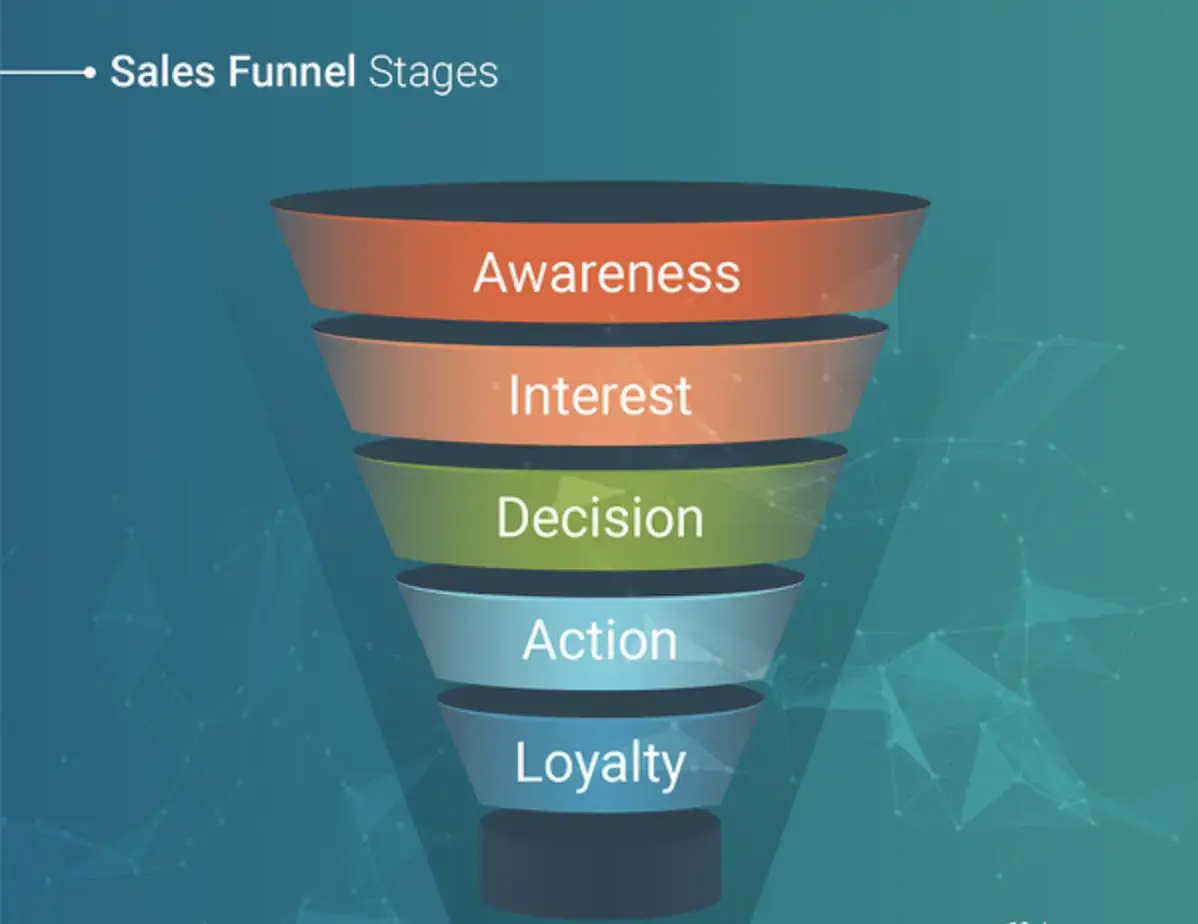The customer buying journey is crucial in acquiring conversions. Without robust marketing strategies, this journey can be negatively affected.
A clear and efficient framework—like a sales funnel—to guide your marketing strategies is essential in ensuring a positive customer journey.
Shortcuts:
- Understanding the Sales Funnel
- The 5 Stages of a Sales Funnel
- The Importance of a Sales Funnel
- Best Practices for Motivating Leads
 Image by Campaign Creators on Unsplash
Image by Campaign Creators on Unsplash
But what is a sales funnel, and how can this marketing structure help you gain and retain customers?
Understanding the Sales Funnel
A sales funnel represents the customer buying journey by visually illustrating how leads go from brand discovery to becoming customers. This framework takes the shape of an inverted pyramid, highlighting the following:
- The broad top portion of the pyramid represents the consumers who become aware of your brand, products, or services.
- The middle portion narrows by showing consumer motivations to go down the funnel to become qualified leads.
- The bottom portion illustrates the final stage, where qualified leads become customers by purchasing or taking action.
Sales funnels have different types depending on your goals.
Sample Sales Funnels:
- Content Creation and Marketing Funnel
- Lead Generation Funnel
- Tripwire Funnel
- Product Launch Funnel
- Email Marketing Funnel
- Video Marketing Funnel
- Live Demo Funnel
The Five Stages of a Sales Funnel
Each sales funnel phase represents a focal point in the customer journey.
 Image from advokate.net
Image from advokate.net
1. Awareness
In this phase, consumers explore your brand, browse your product or service listings, and conduct additional research to learn more about your company.
They mainly search for something that can solve their problems or improve the quality of their lives.
Thus, awareness involves enticing marketing tactics to build attention around your business. The goal is to pique the prospects' curiosity by introducing your brand intriguingly.
Some strategies that foster brand awareness are word-of-mouth promotions, social media marketing, blog posts, and paid ads.
2. Interest
This stage aims to maintain the leads' attention and interest in your brand by providing personalized experiences to encourage them to take action.
However, not all leads are qualified.
Qualified leads are prospects who fit your target audience and are more likely to become your customers.
You evaluate and identify them through lead prospecting, a sales funnel strategy that nurtures their interest.
3. Decision
After finalizing their research, qualified leads enter the decision stage—they're ready to purchase while still considering a few options.
You must emphasize what sets your products or services apart from competitors to persuade qualified leads to go down the action stage. The goal is to give more compelling reasons to choose you.
Consider offering the following benefits:
- Discount vouchers and promo codes
- Free shipping
- Bonus products or gifts
These tangible benefits help influence potential customers to choose your brand.
Moreover, it would be best to have Frequently Asked Questions (FAQ) sections on your website and social media profiles to address common and last-minute queries.
This way, you can further inform and reassure your potential customers.
4. Action
The action stage involves making purchases or taking other actions to become customers. Other actions include:
- Signing up for a service
- Submitting contact details
- Sending inquiries to request more information about your offers
However, this is also the stage where qualified leads may decide not to purchase or take action, requiring you to take actionable steps—like actively engaging with potential customers—to ensure conversions.
5. Loyalty
Many sales funnels stop after the action stage. However, the dynamic and hypercompetitive contemporary marketing landscape requires you to retain your customers for as long as possible.
Although it's the final stage, loyalty is where you continuously nurture your customers' interest so they develop a preference and emotional connection with your brand.
With exceptional after-sales support, you ensure your customers keep returning and advocating for your brand.
Jess Huang, a former partner at McKinsey & Company and YouTube's current managing director, emphasizes,
"You have to go in with eyes wide open and design a program that creates value for the consumer and you. That often involves finding a way to leverage the gap between a consumer's perceived value of something and your cost to provide it."
 Image by Jason Goodman on Unsplash
Image by Jason Goodman on Unsplash
The Importance of a Sales Funnel
Here are the reasons to incorporate sales funnels into your marketing strategies:
-
It helps determine the right marketing tools and strategies
Some brands' current marketing efforts may yield little to no results, signaling that something needs improvement or adjustments. Creating a sales funnel can help if you need help with the same issues.
With sales funnels, you can determine the appropriate marketing tools and tactics that generate the best results.
At the same time, these frameworks provide visual analysis that will guide you in identifying pain points and areas of improvement.
-
Focuses on acquiring qualified leads
Rather than exerting effort on converting all leads, sales funnels help you focus on qualified leads.
They enable you to devote your time and resources to prospects that show genuine and consistent interest in your brand.
This targeted approach helps increase conversion rates while saving time, costs, and resources. Moreover, you can build more meaningful customer relationships that ensure loyalty.
-
Ensures authentic content and interactions that resonate with customers
Sales funnels provide opportunities to understand consumer interests and preferences more deeply.
They help you execute marketing campaigns that target consumer needs at different buying stages, ensuring authentic content and interactions that resonate with potential customers.
For example, a prospect only seeks general information at the awareness stage, so you should provide engaging and informative content.
Then, the needs change as they move down the funnel, prompting you to modify your marketing approaches to match their interests.
-
Provides optimal user experience
"Digitally empowered consumers have high expectations that include a streamlined, convenient experience in every channel—online, on the phone, and in person—and want products and services that exactly meet their needs." - Ursa Mihajlovic, Head of Global Industry Events Strategy at SAP.
Since sales funnels focus on customer needs, they help you personalize your campaigns and optimize your website and social media profiles for an optimal user experience.
These personalization and optimization tactics help you create a seamless customer journey, enhancing satisfaction and the likelihood of customers returning and recommending your brand to others.
-
Identifies competitive advantages
Well-structured sales funnels provide clear direction to execute marketing campaigns efficiently.
At the same time, they let you measure your campaign progress to determine strengths and weaknesses, helping you identify competitive advantages that make your brand stand out.
 Image by Austin Distel on Unsplash
Image by Austin Distel on Unsplash
Best Practices for Motivating Leads To Go Down the Sales Funnel
Motivating qualified leads to go down the sales funnel is a lengthy process. Here are the best practices to efficiently guide your prospects toward becoming customers.
-
Define your target audience and the problems you want to solve
The first step involves understanding potential customers by defining your target audience and their challenges through market research.
Market research identifies your target audience's demographic, location, social class, purchasing power, and spending habits. These factors help determine the common problems you can solve with your products or services.
Furthermore, Solomon Thimothy, CEO of OneIMS, suggests, "While we always follow best practices for funnel creation, we should first take a step back and ask: What does the client want first and foremost? In an ideal world, what is the precise outcome they are looking for?"
Suppose your company sells sustainable home products. Market research helps you determine that your target audiences are homeowners who need eco-friendly alternatives.
Thus, you'll focus on developing and marketing energy-efficient appliances or environmentally safe cleaning products to cater to these conscious consumers' needs.
-
Identify your marketing goals
After defining your target audience, identify your marketing goals by evaluating which areas require the most attention. You should set these goals based on the sales funnel stages.
Examples of goals for each funnel stage include:
-
- Top
-
-
- Increase website traffic
- Strengthen brand awareness
- Boost online presence
-
-
- Middle
-
-
- Enhance lead prospecting and qualification
- Increase subscribers or sign-ups for services
-
-
- Bottom
-
-
- Optimize after-sales support
- Grow upsell rates
- Encourage repeat purchases and brand advocacy
-
-
Publish attention-grabbing content
Once you have your goals, develop content strategies based on these objectives. Then, create and publish attention-grabbing content that can be educational, informative, or promotional.
Examples of content to publish include:
- Blog posts
- Videos
- Infographics
- Social media content (e.g., Instagram carousel posts)
- How-Tos
- Step-by-step tutorials
- Listicles
- Testimonials
- Product or service reviews
- Tips
- News
- Statistics and numerical reports
- Seasonal content (e.g., holiday posts)
- Articles discussing the latest trends
 Image by Annie Spratt on Unsplash
Image by Annie Spratt on Unsplash
-
Create a landing page
Standalone web pages designed exclusively for promotional campaigns are known as landing pages. These pages are often the first opportunities consumers encounter to learn about brands and their products and services.
For instance, consumers might click paid ads that lead to your landing page about a product or exclusive offers.
Therefore, you must create landing pages that clearly describe your brand, products, services, and their benefits.
They should also be visually enticing and user-friendly. At the same time, you must include compelling calls to action (CTAs) to convert visitors into customers effectively.
-
Align strategies based on the qualified leads' actions
Since we've established that qualified leads may or may not become customers at the action stage, align your strategy based on their decisions.
In both cases, you must keep your communication lines open.
For customers, shift your tactics to retention and loyalty. Meanwhile, return to the lead nurturing strategy for those who didn't convert.
These strategic alignments ensure your efforts are consistently targeted and relevant to maximize conversions, re-engagement, and loyalty.
-
Measure progress and identify areas of improvement
Measuring and analyzing progress is essential in every marketing campaign, particularly when re-engaging qualified leads that didn't convert into customers.
According to IBM Power Systems, "The sheer volume of data now available to organizations, businesses and consumers is unprecedented. Computers, smartphones, fitness trackers, and other devices, along with the Internet of Things, are generating torrents of information that can help solve the thorniest problems while unlocking new opportunities."
As such, data analysis provides insights into what's working and what's not in your tactics.
This evaluation involves studying engagement metrics, click-through rates, conversions, and feedback, providing tangible evidence of performance that pinpoints areas where efforts are falling short.
These quantifiable insights enable you to make informed and data-driven decisions.
Moreover, incorporating sentiment analysis into these assessments adds an in-depth understanding of customer feedback.
This approach identifies whether the feedback has positive, negative, or neutral emotions, helping you create more empathetic and customer-centric marketing campaigns.
Build a Sales Funnel That Converts and Retains
Sales funnels are marketing frameworks that enhance strategies by focusing on consumers' buying journeys.
With the best practices above, you can build one that converts and retains, contributing to your company's long-term growth and success.

